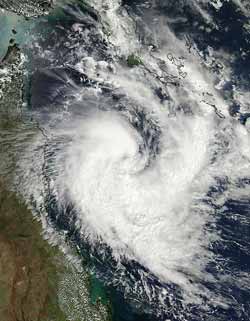NASA Sees Cyclone Tim Develop in the Coral Sea

NASA's Aqua satellite captured a visible image of newborn Tropical Cyclone Tim in the Coral Sea on March 14, 2013 at 04:05 UTC (12:05 a.m. EDT). Note the large band of thunderstorms wrapping into the center from the south and east. Credit: NASA Goddard MODIS Rapid Response Team<br>
The Moderate Resolution Imaging Spectroradiometer (MODIS) instrument aboard NASA's Aqua satellite captured a visible image of Tropical Cyclone Tim in the Coral Sea on March 13, 2013 at 04:05 UTC (12:05 a.m. EDT).
The MODIS image showed a large band of thunderstorms wrapping into the center of circulation from the south and east. Cyclone Tim's northeastern quadrant was brushing Papua New Guinea, and the western quadrant was brushing Queensland Australia's east coast. The MODIS image was created by the MODIS Rapid Response Team at NASA's Goddard Space Flight Center in Greenbelt, Md.
The Joint Typhoon Warning Center noted that animated infrared satellite imagery indicated that the low-level center is consolidating and Tim is showing improved deep convective banding of thunderstorms. An eye was spotted using microwave imagery.
On March 14 at 0900 UTC (5 a.m. EDT), Tim was located 15.2 south latitude and 150.3 east longitude, just 80 nautical miles north of Willis Island, Australia (which is located east of the mainland, Queensland). Maximum sustained winds are near 50 knots (57.5 mph/92.6 kph), and Tim is expected to intensify over the next couple of days before weakening.
Willis Island surface observations from early on March 14 showed peak sustained winds of 37 knots (42.5 mph/68.5 kph) gusting to 45 knots (51.7 mph/83.3 kph).
Tim is expected to move southeast, and pass east of Willis Island, then turn toward the west like a boomerang and head toward Queensland.
Text Credit: Rob Gutro
NASA's Goddard Space Flight Center, Greenbelt, Md.
Media Contact
All latest news from the category: Earth Sciences
Earth Sciences (also referred to as Geosciences), which deals with basic issues surrounding our planet, plays a vital role in the area of energy and raw materials supply.
Earth Sciences comprises subjects such as geology, geography, geological informatics, paleontology, mineralogy, petrography, crystallography, geophysics, geodesy, glaciology, cartography, photogrammetry, meteorology and seismology, early-warning systems, earthquake research and polar research.
Newest articles

Sea slugs inspire highly stretchable biomedical sensor
USC Viterbi School of Engineering researcher Hangbo Zhao presents findings on highly stretchable and customizable microneedles for application in fields including neuroscience, tissue engineering, and wearable bioelectronics. The revolution in…

Twisting and binding matter waves with photons in a cavity
Precisely measuring the energy states of individual atoms has been a historical challenge for physicists due to atomic recoil. When an atom interacts with a photon, the atom “recoils” in…

Nanotubes, nanoparticles, and antibodies detect tiny amounts of fentanyl
New sensor is six orders of magnitude more sensitive than the next best thing. A research team at Pitt led by Alexander Star, a chemistry professor in the Kenneth P. Dietrich…





















